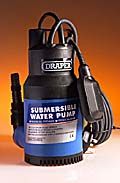I have a drainage problem at the front of my house which results in my garage getting regularly flooded, not to mention a semi permanent pool of water up against the brickwork of the house (albeit below the dpc).
All the drains are located to the rear of the property although there is one surface drain to the side of the garage approximately 3m back and 50cm higher than the garage floor. The drain runs towards the back of the property.
The soil around the property has a high clay content so I expect a natural drainage pit won't work.
My proposal is to dig a trench (approx 1m deep) fill it with gravel and have a sump pump within an inspection chamber at one end. Unfortunately I know nothing about sump pumps so could do with some advice please.
How are permanent sump pumps normally fitted?
Can the pumps be completely submersed, electrics and all?
Which pump would be best suited for the job? (the pit will sit at the bottom of a single car downward sloping drive amd will also have to deal with water draining from the front garden (8mx5m)).
Many thanks.
All the drains are located to the rear of the property although there is one surface drain to the side of the garage approximately 3m back and 50cm higher than the garage floor. The drain runs towards the back of the property.
The soil around the property has a high clay content so I expect a natural drainage pit won't work.
My proposal is to dig a trench (approx 1m deep) fill it with gravel and have a sump pump within an inspection chamber at one end. Unfortunately I know nothing about sump pumps so could do with some advice please.
How are permanent sump pumps normally fitted?
Can the pumps be completely submersed, electrics and all?
Which pump would be best suited for the job? (the pit will sit at the bottom of a single car downward sloping drive amd will also have to deal with water draining from the front garden (8mx5m)).
Many thanks.


